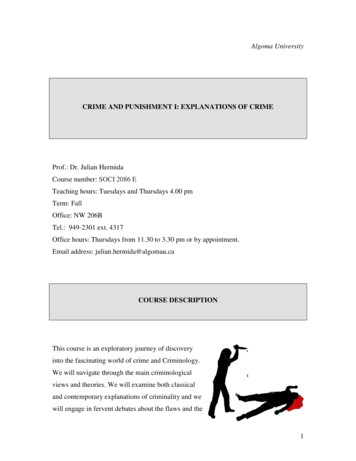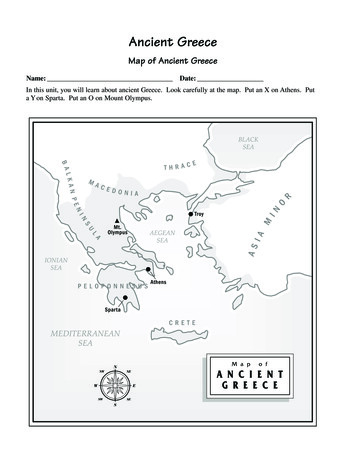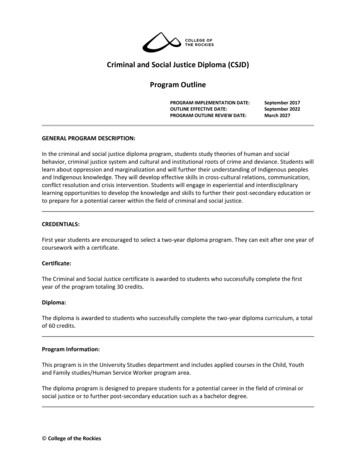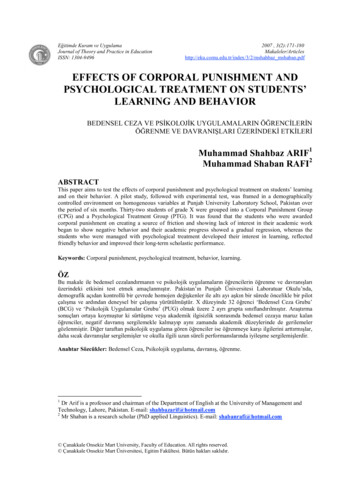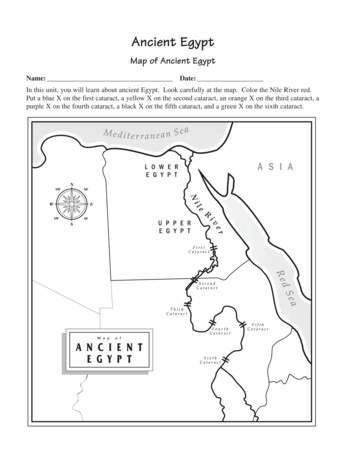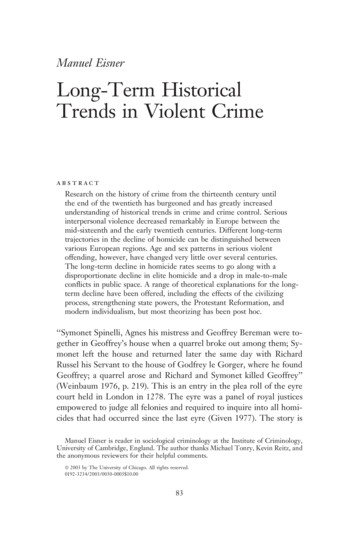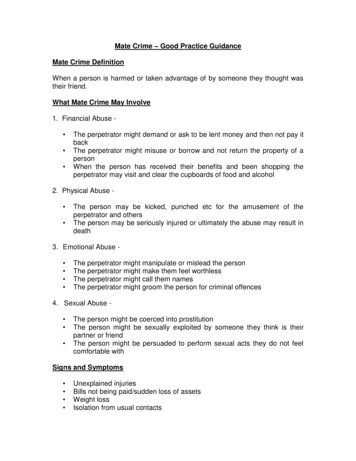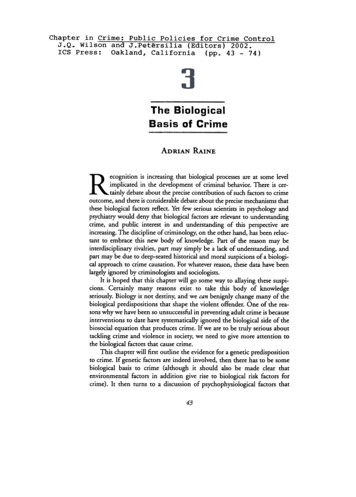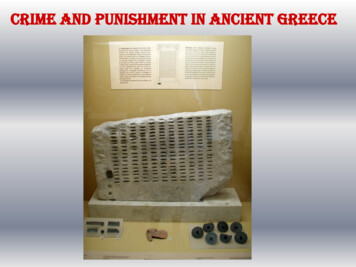
Transcription
CRIME AND PUNISHMENT IN ANCIENT GREECE
LECTURE OUTLINE: OF DRACONIAN MEASURES AND THE WISDOMOF SOLON – CRIME AND PUNISHMENT IN ANCIENT GREECEPRELUDE: ORESTES AND GREEK JUSTICEA. INTRODUCTIONB. EARLY GREEK LAW1. The Homeric Age2. Classical Crete And SpartaC. CRIME, PUNISHMENT AND THE RULE OF LAW IN CLASSICAL ATHENS1. Reforms Of Draco And Solon2. Procedurea)The Basics; b) Preliminaries; c) The Trial; d) The Jury; e) The Verdict3. Types Of Offencesa)Homicide; b) Property Offenses; c) Offenses Against The State; d)Religious Offenses; e) Assault, Abuse, Slander And Hybris4.Women And The Law5.Types Of Punishments
Antigone accompanies her father Oedipus into exile
A bust ofSophocles
A scene from The Clouds (Aristophanes)
A representation of the sacrifice of Iphigenia from Pompeii
Clytemnestra and Aegisthus murder King Agamemnon
John Collier’s“Clytemnestra”(1900)
Orestes kills Aegisthus
Orestes hounded by the Furies
Orestes seeks ritual purification and advice at Delphi
The Areopagus Council Hill in Athens:Scene of the mythic trial of Orestes and later of the Athenian Homicide Court
The trial of Orestes on the Areopagus
LECTURE OUTLINEPRELUDE: ORESTES AND GREEK JUSTICEA. INTRODUCTIONB. EARLY GREEK LAW1. The Homeric Age2. Classical Crete And Sparta
The 5th-century BCE Gortyn Law Code (Crete) is located by the Odeion
The main Gortyn inscription was re-discovered in 1884.
Lycurgus: The historical (?)/ mythical (?) law-giver of Sparta
Draco was an archon who introduced new Athenian laws in 621 BCE.
Solon introduced major legal and social reforms in 594/593 BCE.He would remain an iconic figure, idealized as an all-wise judge.
The “Laws of Solon” were displayed in the Royal Stoa in the Agorawell into the Classical Age.
LECTURE OUTLINEC. CRIME, PUNISHMENT AND THE RULE OF LAW IN CLASSICALATHENS1. The Reforms Of Draco And Solon2. Procedurea) The Basicsb) Preliminariesc) The Triald) The Jurye) The Verdict
The Basics Classical Athens was a participatory democracy runprimarily by amateurs: with the exception of militarygeneralships and a few other posts, state officials wereselected by lot to serve one-year terms. The legal system was run according to these principles ofparticipatory democracy. It was accepted that law andpolitics were inseparable. There was a hostility towards legal professionalism. The language of legal debate (the contest or “agon”) usedthe same metaphors as the wrestling arena or thebattlefield.
The Basics The courts were in session about 200 days a year. There were two main categories of legal procedure:private cases (dikai), in which the victim brought suit, andpublic cases (graphai), in which anyone was permitted toinitiate a suit. With few exceptions, all legal actions were brought by anindividual. To a large extent, anyone pursuing a wrong,against himself or society, was left to do the work which inmodern states is usually done by official bodies.
Policing Athens essentially had no professional policing corps. There were The Eleven, who had the task of caring forthose in prison awaiting trial, and for supervising theexecution of thieves caught red-handed. 300 Scythian slaves helped with crowd control. The major tasks of policing – investigation, apprehension,prosecution, and even enforcement of court decisions –fell to the citizens themselves.
A Classicalrepresentationof a ScythianSlave
Preliminaries The prosecutor faced the task of putting together his case. He might consult the codes of Athenian laws that werescattered throughout the city on stone stelai in publicplaces. The summons was initiated before the magistrate. There was a form of preliminary inquiry, called anakrisis.
Athenian Trials Trials consisted of opening arguments, speeches made byorators for both parties, the reading of pertinent laws anddepositions, the testimony of male witnesses, and closingarguments. The jury members were entirely responsible for decidingquestions both of law and of fact. First the prosecutor and then the defendant made a speech;in some cases each was permitted to speak twice. Each was allowed the same length of time for speaking,measured by a water-clock (klepsydra). Each litigant was expected to speak for himself; he was notallowed to pay for a lawyer to speak on his behalf.
Asurvivingklepsydra
Evidence The Athenians rarely employed forensic evidence in courtand the main work of an investigation was therefore thetask of gathering witnesses. By the fourth century BCE, witnesses merely presentedthemselves in court to confirm a written deposition draftedby the litigant for whom they appeared. A prosecutor could summon a man to appear as a witnessand prosecute him for failure to testify (lipomartyrion). There was no opportunity to cross-examine a witness. For evidence of a slave to be used formally in court, it hadto be extracted under torture (basanos – literally “test”).
Sycophants To encourage public prosecutions, the state in some publiccases gave a prosecutor a proportion of the fine or propertyconfiscated from the offender if he won his case. Men who made a habit of prosecuting for their owndishonorable purposes became known as sycophants. To discourage unjustified prosecution, a law was introducedimposing a penalty on a prosecutor in most kinds of publiccases if he either obtained less than one-fifth of the jury’s votesor abandoned the case before the trial. The penalty was a fine of 1,000 drachmas with (at least in somecases) partial disfranchisement in addition. It was also possible to prosecute a man for being a sycophant.
Athenian Trial By Jury Was well-developed by the 5th-century BCE – emergedfrom the reforms of Solon and the right to appeal anarchon’s verdict to a citizen body called the eliaia. Juries were selected by lot from the entire citizen body. A list of 6,000 potential jurors for the year was drawn up. Sizes of juries ranged from 200 to 1000 men. Each juror was paid three obols a day.
The Verdict At the end of the litigants’ speeches, the jury voted at once,without further advice or deliberation. The majority decided the verdict. The method of voting was by placing pebbles, or later bronzedisks, in urns for conviction or acquittal. Various devicesenable a juror to conceal which way he voted. For some offences the penalty was laid down by law, but inother cases the penalty of the amount of damages had to bedecided by the jury. In such cases, when the guilt verdict had been given againstthe defendant, the prosecutor and the defendant bothproposed a punishment. The jury then voted to decide between them.
Jury voting disks from the 4th century BCE
Homicide Homicide was a special area of law with its own distinctive procedures. There was, for example, a special homicide oath – the diomosia – in whichthe litigants and witnesses alike participated. Homicide was a private matter, with the victims’ relatives having not just afamilial but indeed a sacred responsibility to punish the killer. Purification was required because killing was believed to cause pollution(miasma). The accused was ordered to stay away from certain places after theproceedings had been initiated but before the trial itself. All trials for homicide were held in the open air, so that all might avoid thepollution of going under the same roof as a killer.
Homicide Courts One of the most striking features of homicide law was therange of available courts. There was a set of homicide courts, the most famous ofwhich was the Areopagus Council, manned by formerarchons. Those trials that did not qualify for the Areopagus werejudged by the ephetai at a variety of courts in and aroundAthens.
The Council of the Areopagus tried only cases in which someone wasaccused of killing an Athenian citizen intentionally with his own hand.
The Delphinion: Tried cases in which the accused arguedthat the killing was lawful.
The Palladion: Tried cases in which the person was accusedof unintentional homicide or homicide of an alien or a slave.
Other Homicide Courts If someone already exiled for unintentional homicide wasaccused of committing another homicide intentionally, hecould not enter Attica for trial, but was allowed to make hisdefense from a boat offshore at a place called Phreatto, whilethe ephetai sat on the beach. Homicides alleged to have been committed by an unknownperson, or by an animal or inanimate object, were tried at thePrytaneion, a building on the northern side of the Acropolis. An animal found guilty of homicide was presumably put todeath or driven out of Attica. An inanimate object, such as a stone or a tree which hadfallen on a person and killed him, was cast beyond thefrontiers of Attica.
Procedure In Homicide Cases Three pre-trials (prodikasiai) were held in three separatemonths for homicide cases, with the trial itself in the fourthmonth. We do not know much about the details of these pretrials. Each side made two speeches. At the end of his first speech, the defendant was allowed togo into exile rather than face the possibility of execution. The penalty for intentional homicide was death andconfiscation of property. For unintentional homicide the penalty was exile – anyonewho returned back to Attica could be killed by anyone withimpunity. Exile could be ended with a pardon (aidesis) from thedeceased person’s family.
Property Offenses A person who suspected another of having stolensomething of his might demand admission to his house tosearch it. Summary executions by members of The Eleven could beused against kakourgoi (“evildoers”) caught red-handed. Those who qualified here included kidnappers, clothesstealers, highwaymen, house burglars, temple robbersand pickpockets. Anyone catching such a thief could arrest him and takehim to the Eleven.
Offenses Against The State Athenian democracy was deeply suspicious of publicofficials, and there were procedures in place to try toensure that these figures did not overstep appropriateboundaries. At the end of one’s period in office, every public officialhad to formally render account for his services in aprocess known as euthunai. By the fourth century BCE, this seems to have beenreplaced by the possibility of eisangelia, roughlycomparable to the modern idea of impeachment. Usually, eisangelia was brought directly before the fullassembly.
Special Provisions In an effort to encourage such actions, the prosecutor whofailed to obtain 20% of the votes cast was not punished, aswas the case in other public proceedings. Anyone who suspected treason could go directly to theAssembly or Boule council to report their suspicions ratherthan go through any preliminaries with a magistrate. A slave who participated in such informing (menyis) wasnormally given his freedom, though this may not havebeen a legal requirement.
The Arginousai Generals were charged for abandoning thesurvivors of the Battle of Arginousai in 406 BCE.
Religious Offenses The law stated that at certain festivals no one might seizemoney or other property from another person, even if itwas something to which he was otherwise legally entitled. The procedure of graphe could be used for any impiety(asebia) on any occasion. A number of individuals were prosecuted in the secondhalf of the fifth century BCE for atheism.
Assault, Abuse, Slander And Hybris It was an offense to strike a blow at another person, andan ordinary private case of battery (dike aikeias) could bebrought for it. If two men had a fight in which each hit theother, only the one who struck the first blow was guilty. Athenians had several laws prohibiting slander andabusive language. Another way of dealing with assault or abuse wasavailable if the offense was an act of hybris. Modernwriters often translate it as “arrogance,” but that does notrepresent the range of the Greek word adequately. The offense of hybris perhaps offers a window into theancient Greek understanding of the meaning of malecitizenship.
Athenian Women And Crime Is it a coincidence that the society that bequeathed to usdemocracy was also arguably the most patriarchal in theancient world? Even aristocratic women in Classical Athens had no legalcapacity of their own, but were always under the kyreia orguardianship of a man. Neither women nor children could usually appear in court aswitnesses. If a prosecutor wished to introduce the testimony of a womaninto court, he had to use a process called “oath challenge.” Women were not permitted to serve on juries.
Female Victims The rape of a free Athenian woman was punished by afine of 100 drachmas. The penalty for a man who seduced or committed adulterywith a free woman was death. A man who merely stepped over the threshold of thehouse of another without permission of the owner hadcommitted the crime of outrage. Rape was legally a crime against a woman’s father orhusband. When a married woman was raped, her husband had alegal obligation to divorce her, under penalty of losing hisrights of citizenship.
Female Offenders Women accused of crimes could not defend themselves in court, buthad to rely on a male relative to represent and defend them. If the penalty for a man who committed adultery with the wife of acitizen was death, the penalty for the woman was a miserable life.Legally a divorced adultress could remarry, but in practice this wasunlikely because of her public shame. Abortion was an offense when a woman induced or procured it withoutthe knowledge and consent of her husband or kyrios. There were certain crimes that only alien women and men couldcommit: failure to have a patron; failure to pay the alien tax; simulationof citizenship; and marriage with a citizen. The penalty for marriage with a citizen was being sold into slavery.
The famous 4thcentury BCE case ofNeaira involved theaccusation that shehad violated the lawprohibiting an alienwoman or man livingas if in marriage withan Athenian citizen.
A man about tosolicit sex froma young maleprostitute
Prostitution And Citizenship In Classical Athens Neither female nor male prostitution was illegal. Procuring a free woman or man for seduction was, however, punishableby death. Any guardian who prostituted a boy in his charge or any person whoenticed a youth of citizen status into prostitution by offering him money forsexual favours faced grave penalties. An Athenian male of citizen status who had hired out his body to anyonefor sexual use forfeited his citizen rights. Once an Athenian citizen had forfeited his citizen rights as a result ofhaving been a prostitute, it was a capital crime to attempt to exercise thoserights. The body of a citizen was considered sacrosanct. Anyone who prostituted himself threatened the coherence of democracyfrom within.
A male clientsolicits sex froma femalecourtesan:Prostitutionseen as a proudachievement ofAtheniandemocracy?
Female Prostitution And Athenian Democracy Among the reforms credited to Solon was the institution of brothelsstaffed by slave women at a price that put them within the reach of allcitizens. Commercial sex would no longer be reserved for the wealthy. There would always be a category of persons for citizens to dominate,socially and sexually. The disenfranchisement of male prostitutes and the inexpensiveprovision of female prostitutes can from one perspective be seen aslinked to a new collective image of the citizen body as masculine andassertive, and as in control of its own pleasures. Athenian democracy was marked by a series of dualities: master andslave; dominant and submissive; active and passive; customer andprostitute; citizen and non-citizen; male and female.
Punishment In some categories of cases, the penalty was predetermined by statute. In others, the jury decided thepenalty by a system of counter-assessment. The prosecutor was personally involved to an extent notknown today. There were two categories of punishment – physical andfinancial. Imprisonment was rarely used as a punishment. The picture we get from our sources suggests that deathwas by far the most common of physical penalties, even ifdeath itself was not particularly common.
Forms Of Execution The death penalty was prescribed for men and women for intentionalhomicide, treason and sacrilege, and for men for adultery, seductionand malfeasance in office. Early sources speak about people being thrown into the barathon (atype of pit), but it is not clear whether this was a method of executionor a place for disposing of bodies of criminals. From the fifth century BCE onwards, the most common means ofexecution in Athens was the plank (tympanon), a piece of wood towhich the condemned person was strapped by iron bands around theneck, wrists and ankles. The plank was raised upright and thecondemned died slowly over a period of days. Some offenders convicted of capital crimes were granted the“privilege” of self-execution, perhaps by hemlock. In Classical Athens, capital punishment was frequently named as thepossible penalty, yet there seem to have been relatively few actualexecutions. Exile for intentional homicide was permanent.
Atimia This was a penalty which could only be imposed on malecitizens. Atimia denotes the removal of time (“honour”) – the manso punished and deprived of his honour was described asatimos. The rights lost by the atimos included the right to appear incourt as a litigant or witness, and the right to speak or votein the assembly. The situation of atimoi may have been so intolerable thatmany preferred to move into exile. This penalty was typically life-long, but not usuallyhereditary.
Other Status Distinctions With Punishments Enslavement was a penalty imposed on an alien who resided inAthens without being registered as a metic or paying the metics’ tax. The male citizen could legitimately act outside of institutional channelsto do almost anything to his own slaves. A citizen could also beat any slave caught stealing, even if the slavebelonged to someone else. The male citizen had a similarly far-ranging power over the femalemembers of his household and was expected to punish the women inhis household when necessary. Male citizens who wished to punish fellow male citizens needed toproceed through the court system except in those instances in whichjustifiable homicide was an acceptable response.
A comicrespresentationof a master (onthe right) withhis slave (4th c.BCE)
Homicide Homicide was a special area of law with its own distinctive procedures. There was, for example, a special homicide oath - the diomosia - in which the litigants and witnesses alike participated. Homicide was a private matter, with the victims' relatives having not just a
